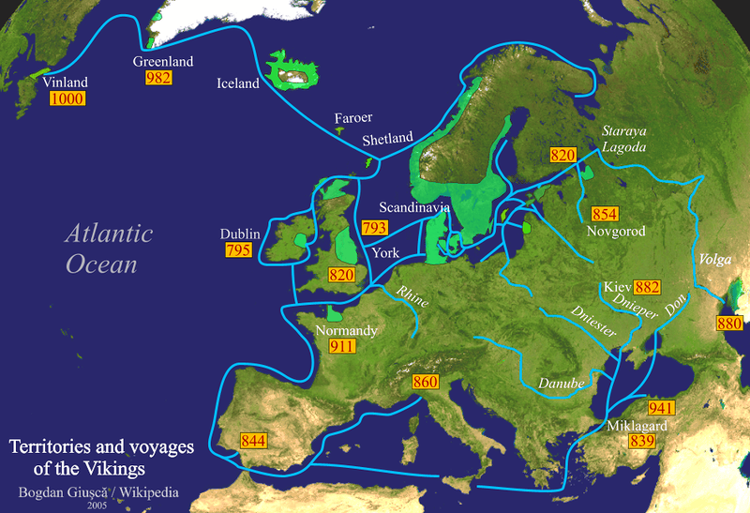The Viking Age
The Viking Age is deemed to have begun on June 8, 793. Longships with dragon prows appeared off the island of Lindisfarne, pulled in and disgorged
Norwegian raiders who slew the monks - in fact anyone who had not arrived with them - and carried off an immense quantity of ecclesiastical equipment
and treasure. Alcuin's report captures some of the shock and horror felt in England: "Never before has such terror appeared in Britain as we have now
suffered from a pagan race. . . .The heathens poured out the blood of saints around the altar, and trampled on the bodies of saints in the temple of
God, like dung in the streets." The survivors fled across the causeway to the Northumbrian mainland, taking with them the body of St. Cuthbert, which
was reinterred at Durham. The monastery was not re-established until Norman times.
Jarrow was raided the following year, albeit less successfully.
The Anglo-Saxon Chronicle actually reports the first Viking raid to have been a much smaller incident three or four years earlier: three ships from
Hördaland pulled in to Portland, Dorset, and when the harbormaster asked them their business, he was killed.
It started with Norwegians, but Danes and Swedes were soon doing it too: sailing their beautifully designed, fast ships, with the shallow draft that
enabled them to come right up onto the beach, or far up a river, all around the coasts of western Europe, raiding and plundering. Monasteries were favorite
targets because they were repositories of wealth and the monks were unarmed and poor fighters. In 794, according to the Annals of Ulster, there was a serious
attack on Lindisfarne's mother-house of Iona, followed in 795 by raids upon the northern coast of Ireland. From bases there, they were able to attack Iona
again in 802, cause great slaughter amongst the Céli Dé Brethren, and burn the abbey to the ground. But cities could also be raided, or better yet held for
ransom. Paris was raided in 845, held to ransom twice in the 860s, and subjected to a devastating siege in 885-86; the slow and unsympathetic response by the
Carolingian Emperor doomed Charlemagne's empire never to be reassembled and hastened the end of Carolingian rule itself.
After 850, many vikings started to remain in France, repeatedly sacking Rouen and various smaller towns. They were known as the Great Heathen Army or simply
the Great Army.
One of the two viking commanders in the Siege of Paris was Rollo, or Hrólf. He later returned to the Seine in command of the so-called Great Army. In 911
Rollo's forces were defeated at the Battle of Chartres by the troops of King Charles the Simple. In the aftermath of the battle, rather than pay Rollo to
leave, as was customary, Charles decided to give Rollo and the Great Army the coastal lands they occupied under the condition that he defend against other
raiding Vikings. In the Treaty of Saint-Clair-sur-Epte, Rollo pledged feudal allegiance to the king, changed his name to the Frankish version, and converted
to Xianity, probably with the baptismal name Robert. In return, King Charles granted him the lower Seine area (today's upper Normandy) and the titular
rulership of Normandy, centred around the city of Rouen. But according to legend Rollo refused to kiss the king's foot and ordered one of his warriors to do
it for him; instead of stooping, the man then lifted the king's foot up to his mouth so he fell on the ground. And according to the historian Adhemar, "As
Rollo's death drew near, he went mad and had a hundred Xian prisoners beheaded in front of him in honour of the gods whom he had worshipped, and in the end
distributed a hundred pounds of gold around the churches in honour of the true God in whose name he had accepted baptism."
What caused Scandinavians to start going a-viking is uncertain, but population pressures, especially in the limited farming territories in Norway, were
undoubtedly a major factor. Stenton points to the Frankish destruction of Frisian and Saxon power, which left no one with a fleet guarding the North Sea
(240). It has also been argued that Lindisfarne had formerly been a heathen sacred site, and that Aidan's monastery was thus an affront. Even if it was not
so, the monasteries - especially those on islands - must have seemed like fruits dangling ready for the plucking. Most viking warriors who did not die in the
course of their raiding saved enough spoils and then bought a farm. Destruction for its own sake was not a big motivation, although they liked to give that
impression to increase fear.
Map of areas affected by viking raids and conquests, with years:

Map Created by Bogdangiusca, Wikimedia Commons
[1. Viking Raid map image from http://en.wikipedia.org/wiki/Image:Vikings-Voyages.png]
